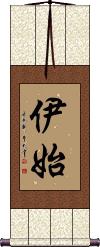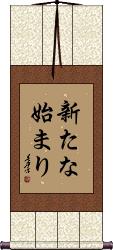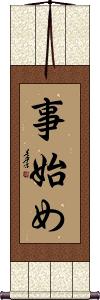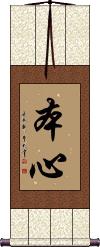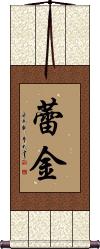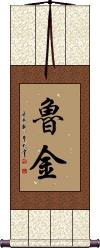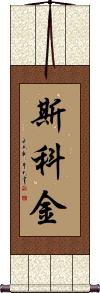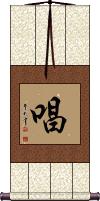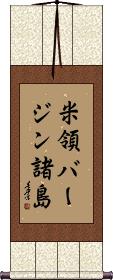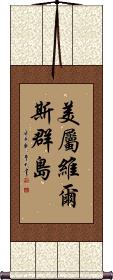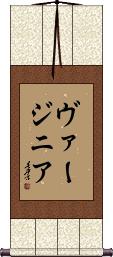The Name Gin in Japanese/Chinese on a Custom-Made Wall Scroll.
Click the "Customize" button next to your name below to start your personalized gin calligraphy artwork...
Switched to secondary search mode due to lack of results using primary.
These secondary results may not be very accurate. Try a different but similar meaning word or phrase for better results. Or...
Look up Gin in my Japanese Kanji & Chinese Character Dictionary(My dictionary is a different system then the calligraphy search you just tried)
If you want a special phrase, word, title, name, or proverb, feel free to contact me, and I will translate your custom calligraphy idea for you.
3. Mark the boat to find the lost sword / Ignoring the changing circumstances of the world
4. Coggins
6. Engineer
7. Failure is the Origin of Success
9. Georgina
10. Gin
11. Gina
12. Gines
13. Ginette
14. Gingell
15. Ginger
16. Ginjima
17. Ginnifer
18. Ginny
19. Gino
20. Higginbotham
21. Huggins
22. Iginio
23. Imagination
25. A Journey of 1000 Miles Begins with a Single Step
26. Kama - Desire Wish Longing
27. Kansei Engineering / Sense Engineering
28. Keegin
30. Luginar
31. McGinily
32. Mcginily
33. Mcginley
34. Mcginnis
35. McGinnis
37. Morgin
39. New Beginning
41. Regina
42. Reginald
43. Regine
44. Rugin
45. Scoggin
46. Changing Oneself / Self Reformation
47. Sing / Singing
49. Virginia
50. Virginie
51. Wiggins
Mind of the Beginner
Shoshin
初心 is often translated in Japanese as “beginner's mind” or “beginner's spirit.”
In Chinese, the dictionary definition is “one's original intention.”
The first character means first, initial, primary, junior, beginning, or basic.
The second character means heart, mind, soul, or essence.
初心 is one of the five spirits of the warrior (budo) and is often used as a Japanese martial arts tenet. Under that context, places such as the Budo Dojo define it this way: The state of shoshin is that of a beginners mind. It is a state of awareness that always remains fully conscious, aware, and prepared to see things for the first time. The attitude of shoshin is essential to continued learning.
British Virgin Islands
英屬維爾斯群島 is the Chinese name for the British Virgin Islands (overseas territory of the United Kingdom).
See Also: United States Virgin Islands | North America
Mark the boat to find the lost sword / Ignoring the changing circumstances of the world
刻舟求劍 is an originally-Chinese proverb that serves as a warning to people that things are always in a state of change.
Thus, you must consider that and not depend on the old ways or a way that may have worked in the past but is no longer valid.
This idiom/proverb comes from the following story:
A man was traveling in a ferry boat across a river. With him, he carried a treasured sword. Along the way, the man became overwhelmed and intoxicated by the beautiful view and accidentally dropped his prized sword into the river. Thinking quickly, he pulled out a knife and marked on the rail of the boat where exactly he had lost his sword.
When the boat arrived on the other side of the river, the man jumped out of the boat and searched for his sword right under where he'd made the mark. Of course, the boat had moved a great distance since he made the mark, and thus, he could not find the sword.
While this man may seem foolhardy, we must take a great lesson from this parable: Circumstances change, so one should use methods to handle the change. In modern China, this is used in business to mean that one should not depend on old business models for a changing market.
This proverb dates back to the Spring and Autumn period (770–476 BC) of the territory now known as China. It has spread and is somewhat known in Japan and Korea.
Coggins
Coggins
Desire / Longing / Craving
慾 means desire, longing, appetite, wish, covetousness, greed, passion, desire, avarice, and craving.
慾 is universal in Chinese, Japanese Kanji, and Korean Hanja.
The context in which this character is used determines whether the meaning is good or bad. As a single character on a wall scroll, you get to decide what the definition is to you (hopefully more toward desire than greed).
![]() Please note that Japanese use a simplified version of this character - it also happens to be the same simplification used in mainland China. Click on the character to the right if you want the Japanese/Simplified version of desire.
Please note that Japanese use a simplified version of this character - it also happens to be the same simplification used in mainland China. Click on the character to the right if you want the Japanese/Simplified version of desire.
Engineer
工程師 is the occupational title of an engineer in Chinese.
In China, an engineer might have a sign on his desk or a name badge with his/her name on it and this title. It's not too common to see this on a wall scroll in China, but you are allowed to take such liberties in the west.
Note that in China, a wall scroll like this is sometimes given to a teacher who builds (engineers) the spirits of their students. It's a way to honor a teacher, and in this case, the meaning departs from an occupational title.
Engineer
Failure is the Origin of Success
This Japanese proverb reads, “failure/mistake/blunder/defeat is the origin of success.”
It suggests that failures or defeats are a necessary part of success.
失敗は成功の元 is often translated as “Failure is a stepping stone to success.”
Note: There are a few similar variations of this idiom in Japanese.
Note: Because this selection contains some special Japanese Hiragana characters, it should be written by a Japanese calligrapher.
See Also: Failure is a Stepping Stone to Success
Begging Forgiveness
Georgina
Georgina
Gina
Gina
Gines
Gines
Ginette
Ginette
Gingell
Gingell
Ginger
Ginger
Ginger
薑 is the Chinese, Japanese Kanji, and old Korean Hanja word for ginger root (Zingiber officinale).
薑 is also the Chinese surname Jiang, or the Japanese surname Hajikami.
Sometimes, this can refer to a Japanese pepper (Zanthoxylum piperitum).
Ginjima
Ginjima
Ginnifer
Ginny
Ginny
Gino
Gino
Higginbotham
Higginbotham
Huggins
Huggins
Iginio
Iginio
Imagination
想像力 is probably the best way to express “imagination” in Chinese, Japanese Kanji, and old Korean Hanja.
It literally means “your strength to imagine.” The last character means strength or ability, while the first two mean imagine or conceptualize. My Japanese dictionary defines this as “The power of imagination.” While my Korean dictionary says, “imaginative power.”
Imagine / Imagination
想像 is the shortest word for imagine, visualize, or imagination.
It can also mean “to guess,” (which is why I favor the 3-character version of imagination (just a third character is added to the end, which clarifies it).
A Journey of 1000 Miles Begins with a Single Step
A Journey of 1000 Miles Begins with a Single Step
senri no michi mo ippo kara
千里の道も一歩から is the Japanese version of an ancient Chinese proverb that means “a journey of a thousand miles begins with a single step.”
Some will also translate this as a 1000-mile road starts with one brick (a small amount).
In this case, the real measurement is an ancient Chinese “li” or 里, which is romanized as “ri” in Japanese. It's about half a kilometer, so three 里 would be a western mile. A journey of 333 miles begins with a single step, just doesn't sound as natural.
Note: Because this selection contains some special Japanese Hiragana characters, it should be written by a Japanese calligrapher.
Kama - Desire Wish Longing
欲樂 is the Chinese and Japanese title representing the Buddhist and Jainist joys of the five desires.
Kama comes from the Pali/Sanskrit काम. The meaning is “desire, wish, longing.”
In Jainism, it can include sensual pleasure, sexual desire, and longing.
However, the Buddhist context refers more to any desire, wish, passion, longing, the pleasure of the senses, desire for, longing to and after, the aesthetic enjoyment of life, affection, or love, enjoyment of love is particularly with or without the enjoyment of sexual, sensual and erotic desire, and is often used without sexual connotations.
Kansei Engineering / Sense Engineering
In short, 感性工學 or Kansei engineering involves collecting data on human experiences with a product and then designing or engineering improvements based on those experiences or “senses.”
Some may define Kansei as “engineering around the human experience.”
There is a lot more to know about Kansei, but if you are looking for this word, you probably already know the big picture.
Note: This term is very new in China and is only used by businesses, factories, and engineers that are implementing TQM principles. While the characters have the same base meaning in both languages, this is a Japanese title that flows back into the Chinese language (in history, most things flowed from China to Japan). To a Chinese person unfamiliar with this concept, they may interpret this as “sense vocational studies,” which doesn't make much sense. You may have to explain the intended meaning to some Chinese viewers. But that can make it a great conversation piece.
Kansei is also a newer term in Korean and is only used in certain parts of the industry, with the definition of “Sensory Engineering.” Not yet in widespread use in Korea.
Above is the modern Japanese version of this title. The last character has a Traditional Chinese version, making this 感性工學 instead of 感性工学. If you want the Traditional Chinese version, please include special instructions or email me so that I make sure the calligrapher writes the version you want.
See Also: Kaizen
Keegin
Keegin
Longing for Lover
Luginar
Luginar
McGinily
Mcginily
Mcginley
Mcginley
Mcginnis
McGinnis
Military Engineering
Morgin
Morgin
Naginata / Halberd
New Beginning
New Beginning
伊始 is a short version of “new beginning” or simply “beginning” in Chinese characters.
You can also translate this as “from this moment on,” “starting now,” or “henceforth.”
In the day-to-day speech, this word can apply to starting a new job, beginning a new career, entering a new chapter of your life, or taking a new position (in politics, scholarship, etc.).
New Beginning
新たな始まり is a Japanese word that means “new beginning” or “new start.”
Here's the character breakdown:
新た (arata) = new; fresh; novel; newly; freshly; or this can be like the prefix “re-” like “re-start” or “reset.”
な (na) is kind of a connecting article. This glues “new” to “beginning.”
始まり (hajimari) = origin; beginning.
Note: Because this selection contains some special Japanese Hiragana characters, it should be written by a Japanese calligrapher.
New Beginning
New Beginning
新しい始め is a verbose Japanese phrase that means “new beginning.”
The first three characters mean new, novel, fresh, recent, latest, up-to-date, or modern.
The last two characters mean beginning, start outset, opening, or origin.
Note: Because this selection contains some special Japanese Hiragana characters, it should be written by a Japanese calligrapher.
The Original Mind
In Zen Buddhism, 本心 means “original mind” or “original heart,” which refers to one's Buddha-nature present from birth.
This can also be translated as true feelings, real intention, one's own heart, one's right mind, one's senses, one's conscience, or fundamental mind.
Note: 心 can mean heart or mind - thought in ancient Asia to be the same organ.
Regina
Regina
Reginald
Reginald
Regine
Regine
Rugin
Rugin
Scoggin
Scoggin
Changing Oneself / Self Reformation
Sing / Singing
唱 is how to refer to singing or song in Chinese.
In Japanese, the meaning is similar but more closely means chant, recite or yell. Best if your audience is Chinese.
U.S. Virgin Islands
U.S. Virgin Islands
This is the Chinese name for the United States Virgin Islands (overseas territory of the United States).
See Also: North America | British Virgin Islands
Virginia
Virginia
Virginie
Virginie
Wiggins
Wiggins
The following table may be helpful for those studying Chinese or Japanese...
| Title | Characters | Romaji (Romanized Japanese) | Various forms of Romanized Chinese | |
| Mind of the Beginner | 初心 | sho shin / shoshin | chū xīn / chu1 xin1 / chu xin / chuxin | ch`u hsin / chuhsin / chu hsin |
| British Virgin Islands | 英屬維爾斯群島 英属维尔斯群岛 | yīng shǔ wéi ěr sī qún dǎo ying1 shu3 wei2 er3 si1 qun2 dao3 ying shu wei er si qun dao yingshuweiersiqundao | ying shu wei erh ssu ch`ün tao yingshuweierhssuchüntao ying shu wei erh ssu chün tao |
|
| Mark the boat to find the lost sword Ignoring the changing circumstances of the world | 刻舟求劍 刻舟求剑 | kokushuukyuuken kokushukyuken | kè zhōu qiú jiàn ke4 zhou1 qiu2 jian4 ke zhou qiu jian kezhouqiujian | k`o chou ch`iu chien kochouchiuchien ko chou chiu chien |
| Coggins | 科金斯 | kē jīn sī ke1 jin1 si1 ke jin si kejinsi | k`o chin ssu kochinssu ko chin ssu |
|
| Coggins | コギンズ | koginzu | ||
| Desire Longing Craving | 慾 欲 | yoku | yù / yu4 / yu | yü |
| Engineer | 工程師 工程师 | gōng chéng shī gong1 cheng2 shi1 gong cheng shi gongchengshi | kung ch`eng shih kungchengshih kung cheng shih |
|
| Engineer | 工学者 | kougakusha / kogakusha | ||
| Failure is the Origin of Success | 失敗は成功の元 | shippai wa seikou no moto shippaiwaseikounomoto shipai wa seiko no moto | ||
| Begging Forgiveness | 饒恕 饶恕 | ráo shù / rao2 shu4 / rao shu / raoshu | jao shu / jaoshu | |
| Georgina | 喬姬娜 乔姬娜 | qiáo jī nà qiao2 ji1 na4 qiao ji na qiaojina | ch`iao chi na chiaochina chiao chi na |
|
| Georgina | ジョージーナ | joojiina / jojina | ||
| Gin | 杜松子酒 | dù sōng zǐ jiǔ du4 song1 zi3 jiu3 du song zi jiu dusongzijiu | tu sung tzu chiu tusungtzuchiu |
|
| Gin | 金 | jīn / jin1 / jin | chin | |
| Gin | ジン | jin | ||
| Gina | 吉娜 | jí nà / ji2 na4 / ji na / jina | chi na / china | |
| Gina | ジーナ | jiina / jina | ||
| Gines | 希內斯 希内斯 | xī nèi sī xi1 nei4 si1 xi nei si xineisi | hsi nei ssu hsineissu |
|
| Gines | ジネス | jinesu | ||
| Ginette | 吉內特 吉内特 | jí nèi tè ji2 nei4 te4 ji nei te jineite | chi nei t`e chineite chi nei te |
|
| Ginette | ジネット | jinetto | ||
| Gingell | 金格爾 金格尔 | jīn gé ěr jin1 ge2 er3 jin ge er jingeer | chin ko erh chinkoerh |
|
| Gingell | ジンゲル | jingeru | ||
| Ginger | 金蔗爾 金蔗尔 | jīn zhè ěr jin1 zhe4 er3 jin zhe er jinzheer | chin che erh chincheerh |
|
| Ginger | ジンジャー | jinjaa / jinja | ||
| Ginger | 薑 姜 | hajikami / shouga hajikami / shoga | jiāng / jiang1 / jiang | chiang |
| Ginjima | 銀島 银岛 | yín dǎo / yin2 dao3 / yin dao / yindao | yin tao / yintao | |
| Ginjima | ギンジマ | ginjima | ||
| Ginnifer | 珍妮佛 | zhēn nī fú zhen1 ni1 fo2 zhen ni fo zhennifo | chen ni fo chennifo |
|
| Ginny | 金妮 | jīn nī / jin1 ni1 / jin ni / jinni | chin ni / chinni | |
| Ginny | ジニー | jinii / jini | ||
| Gino | 吉諾 吉诺 | jí nuò / ji2 nuo4 / ji nuo / jinuo | chi no / chino | |
| Gino | ジノ | jino | ||
| Higginbotham | 希金波坦 | xī jīn bō tǎn xi1 jin1 bo1 tan3 xi jin bo tan xijinbotan | hsi chin po t`an hsichinpotan hsi chin po tan |
|
| Higginbotham | ヒギンボサム | higinbosamu | ||
| Huggins | 哈金斯 | hā jīn sī ha1 jin1 si1 ha jin si hajinsi | ha chin ssu hachinssu |
|
| Huggins | ハギンズ | haginzu | ||
| Iginio | 伊吉尼奧 伊吉尼奥 | yī jí ní ào yi1 ji2 ni2 ao4 yi ji ni ao yijiniao | i chi ni ao ichiniao |
|
| Iginio | イジニオ | ijinio | ||
| Imagination | 想像力 | souzouryoku sozoryoku | xiǎng xiàng lì xiang3 xiang4 li4 xiang xiang li xiangxiangli | hsiang hsiang li hsianghsiangli |
| Imagine Imagination | 想像 | souzou / sozo | xiǎng xiàng xiang3 xiang4 xiang xiang xiangxiang | hsiang hsiang hsianghsiang |
| A Journey of 1000 Miles Begins with a Single Step | 千里之行始於足下 千里之行始于足下 | qiān lǐ zhī xíng shǐ yú zú xià qian1 li3 zhi1 xing2 shi3 yu2 zu2 xia4 qian li zhi xing shi yu zu xia qianlizhixingshiyuzuxia | ch`ien li chih hsing shih yü tsu hsia chien li chih hsing shih yü tsu hsia |
|
| A Journey of 1000 Miles Begins with a Single Step | 千里の道も一歩から | sen ri no michi mo i-ppo ka ra senrinomichimoi-ppokara sen ri no michi mo i-po ka ra | ||
| Kama - Desire Wish Longing | 欲樂 欲乐 | yokuraku | yù lè / yu4 le4 / yu le / yule | yü le / yüle |
| Kansei Engineering Sense Engineering | 感性工學 感性工学 | kansei kougaku kanseikougaku kansei kogaku | gǎn xìng gōng xué gan3 xing4 gong1 xue2 gan xing gong xue ganxinggongxue | kan hsing kung hsüeh kanhsingkunghsüeh |
| Keegin | 基金 | jī jīn / ji1 jin1 / ji jin / jijin | chi chin / chichin | |
| Keegin | キーギン | kiigin / kigin | ||
| Longing for Lover | 思戀 思恋 | sī liàn / si1 lian4 / si lian / silian | ssu lien / ssulien | |
| Luginar | 魯吉納 鲁吉纳 | lǔ jí nà lu3 ji2 na4 lu ji na lujina | lu chi na luchina |
|
| Luginar | ルギナー | ruginaa / rugina | ||
| McGinily | 麥金利 麦金利 | mài jīn lì mai4 jin1 li4 mai jin li maijinli | mai chin li maichinli |
|
| Mcginily | マクギニリー | makuginirii makuginiri | ||
| Mcginley | 麥金利 麦金利 | mài jīn lì mai4 jin1 li4 mai jin li maijinli | mai chin li maichinli |
|
| Mcginley | マッギンリー | magginrii / maginri | ||
| Mcginnis | 麥金尼斯 麦金尼斯 | mài jīn ní sī mai4 jin1 ni1 si1 mai jin ni si maijinnisi | mai chin ni ssu maichinnissu |
|
| McGinnis | ムクジニス | mukujinisu | ||
| Military Engineering | 工兵 | kouhei / kohei | gōng bīng gong1 bing1 gong bing gongbing | kung ping kungping |
| Morgin | 莫金 | mò jīn / mo4 jin1 / mo jin / mojin | mo chin / mochin | |
| Morgin | モージン | moojin / mojin | ||
| Naginata Halberd | 薙刀 | naginata | ||
| New Beginning | 新的開始 新的开始 | xīn de kāi shǐ xin1 de kai1 shi3 xin de kai shi xindekaishi | hsin te k`ai shih hsintekaishih hsin te kai shih |
|
| New Beginning | 伊始 | yī shǐ / yi1 shi3 / yi shi / yishi | i shih / ishih | |
| New Beginning | 新たな始まり | arata na hajimari aratanahajimari | ||
| New Beginning | 事始め | kotohajime | ||
| New Beginning | 新しい始め | atarashii hajime atarashiihajime atarashi hajime | ||
| The Original Mind | 本心 | hon shin / honshin | běn xīn / ben3 xin1 / ben xin / benxin | pen hsin / penhsin |
| Regina | 蕾吉娜 | lěi jí nà lei3 ji2 na4 lei ji na leijina | lei chi na leichina |
|
| Regina | レジーナ | rejiina / rejina | ||
| Reginald | 雷金納德 雷金纳德 | léi jīn nà dé lei2 jin1 na4 de2 lei jin na de leijinnade | lei chin na te leichinnate |
|
| Reginald | レジナルド | rejinarudo | ||
| Regine | 蕾金 | lěi jīn / lei3 jin1 / lei jin / leijin | lei chin / leichin | |
| Regine | レジン | rejin | ||
| Rugin | 魯金 鲁金 | lǔ jīn / lu3 jin1 / lu jin / lujin | lu chin / luchin | |
| Rugin | ルージン | ruujin / rujin | ||
| Scoggin | 斯科金 | sī kē jīn si1 ke1 jin1 si ke jin sikejin | ssu k`o chin ssukochin ssu ko chin |
|
| Scoggin | スコギン | sukogin | ||
| Changing Oneself Self Reformation | 自己改革 | ji ko kai kaku jikokaikaku | ||
| Sing Singing | 唱 | chàng / chang4 / chang | ch`ang / chang | |
| U.S. Virgin Islands | 米領バージン諸島 | bei ryou baa jin sho tou beiryoubaajinshotou bei ryo ba jin sho to | ||
| U.S. Virgin Islands | 美屬維爾斯群島 美属维尔斯群岛 | měi shǔ wéi ěr sī qún dǎo mei3 shu3 wei2 er3 si1 qun2 dao3 mei shu wei er si qun dao meishuweiersiqundao | mei shu wei erh ssu ch`ün tao meishuweierhssuchüntao mei shu wei erh ssu chün tao |
|
| Virginia | 維吉尼亞 维吉尼亚 | wéi jí ní yà wei2 ji2 ni1 ya4 wei ji ni ya weijiniya | wei chi ni ya weichiniya |
|
| Virginia | ヴァージニア | vaajinia / vajinia | ||
| Virginie | 維吉尼 维吉尼 | wéi jí ní wei2 ji2 ni2 wei ji ni weijini | wei chi ni weichini |
|
| Virginie | ヴァージニー | vaajinii / vajini | ||
| Wiggins | 威金斯 | wēi jīn sī wei1 jin1 si1 wei jin si weijinsi | wei chin ssu weichinssu |
|
| Wiggins | ウィギンズ | wiginzu | ||
| In some entries above you will see that characters have different versions above and below a line. In these cases, the characters above the line are Traditional Chinese, while the ones below are Simplified Chinese. | ||||
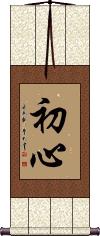
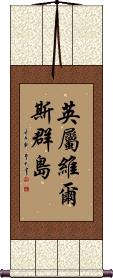



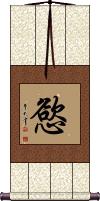
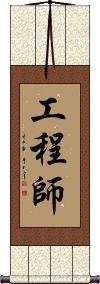

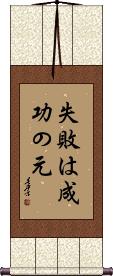
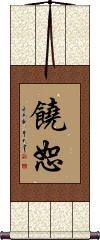
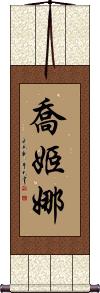
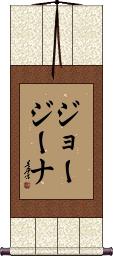

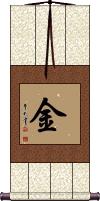
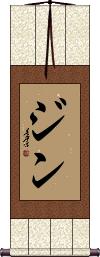
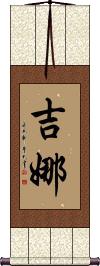

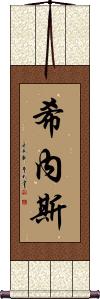



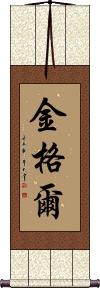

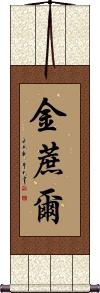

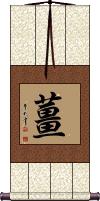


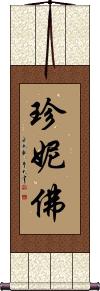
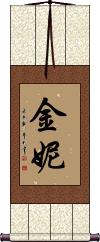
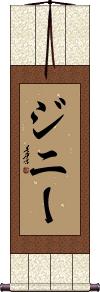
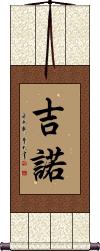
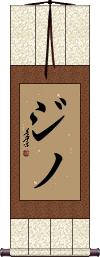

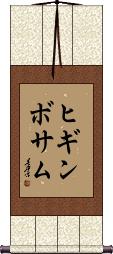
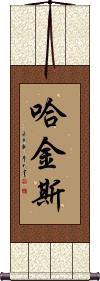



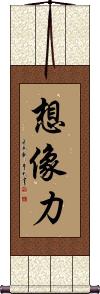
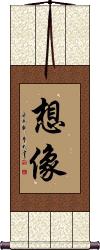
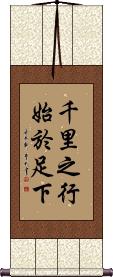
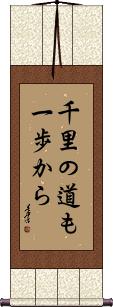
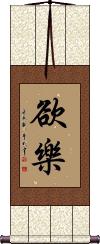

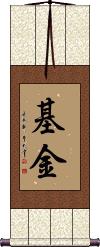

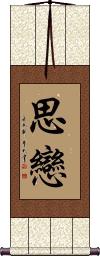


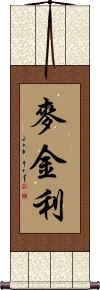
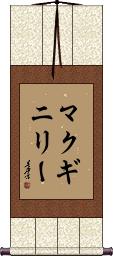
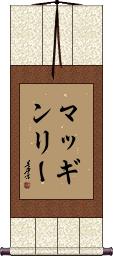


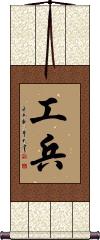
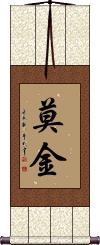

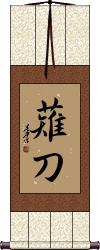
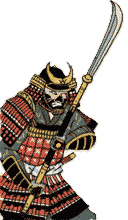 A naginata is a special kind of halberd or long sword carried by some Samurai and other warriors. It is still used ceremonially in some schools of martial arts.
A naginata is a special kind of halberd or long sword carried by some Samurai and other warriors. It is still used ceremonially in some schools of martial arts.
